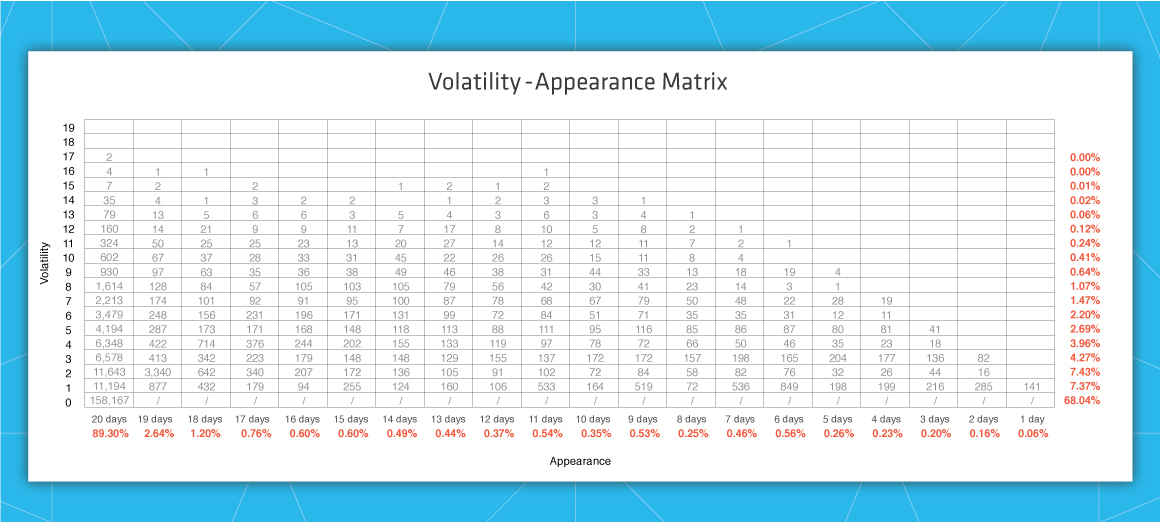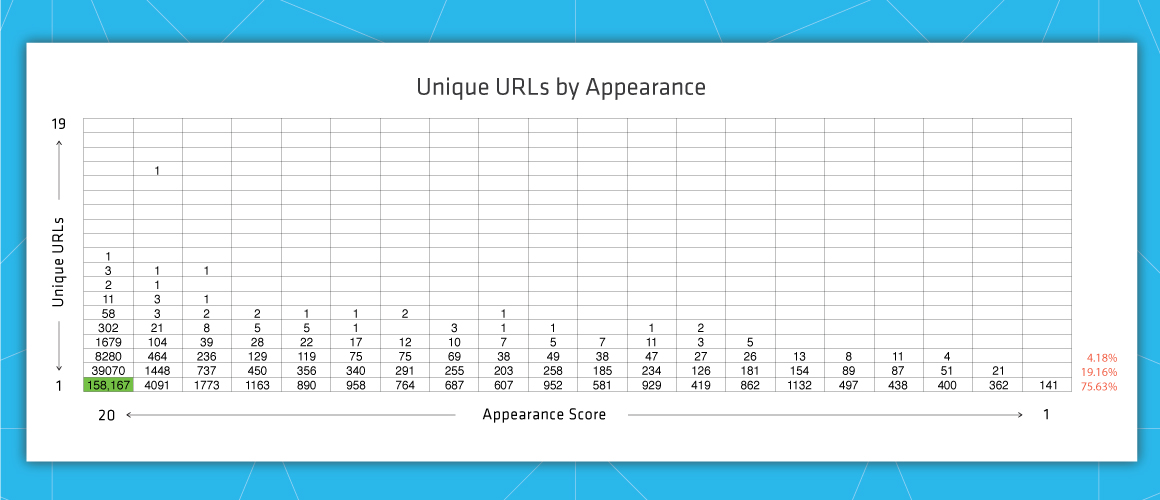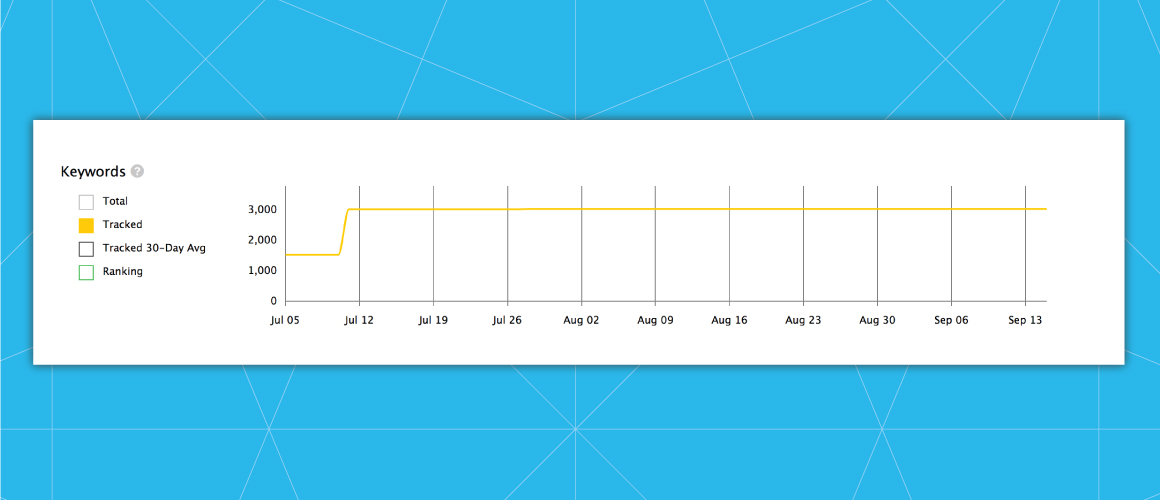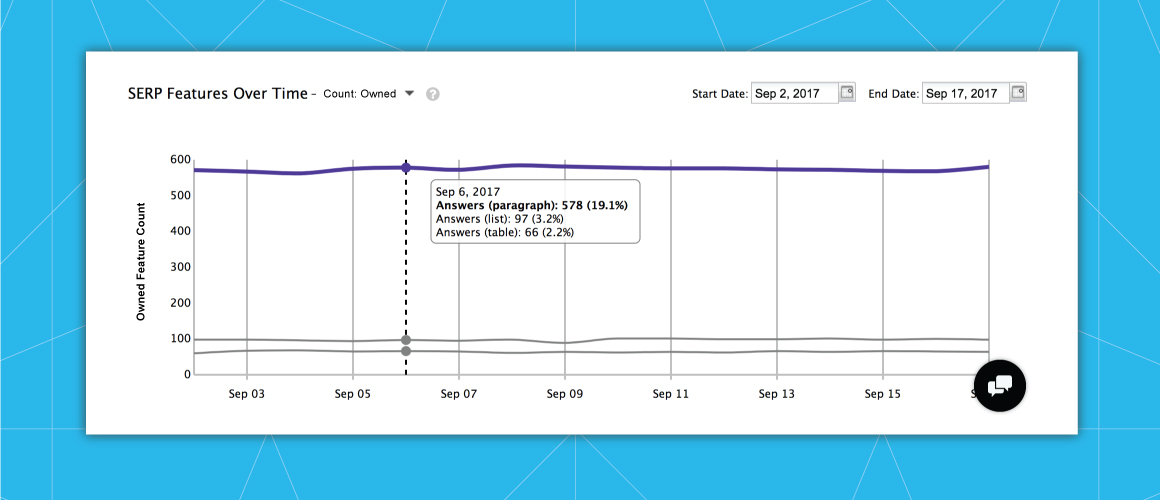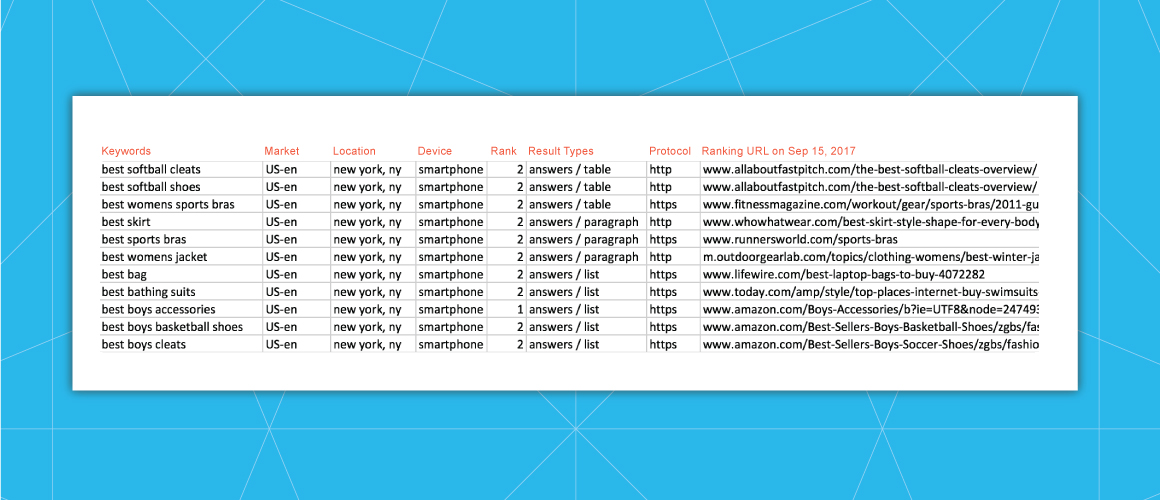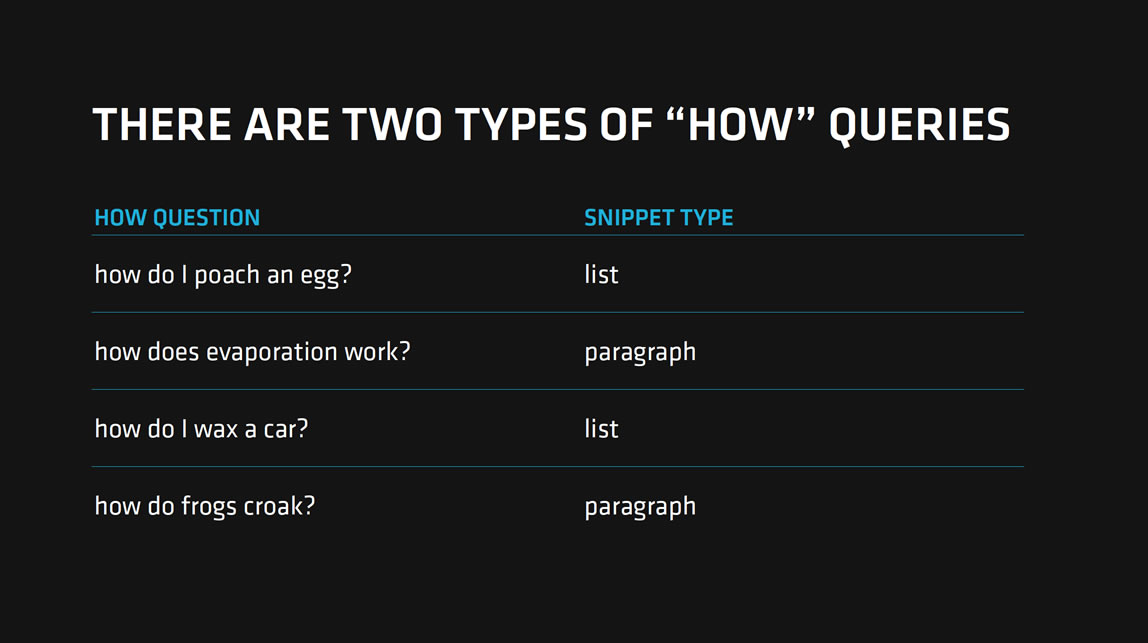Sixty-eight percent of featured snippets are stable — but what exactly are the volatile ones up to? We find out.
Since we *cue 80s music for the SEO-obsessed* just can’t get enough of featured snippets, we thought we’d snoop on them some more. This time, we were interested in their comings and goings.
So, like the SERP-stalkers we are, we tracked the featured snippets of over 200,000 keywords for 20 days, gathering all kinds of intel along the way. Every rank move they made, every URL bond they broke, we were watching.
To give ourselves a handy framework for the analysis, we created a scoring system that added points for a snippet’s appearances, and its various types of volatility, and then plotted where the two scores intersected for each keyword. If you’re curious about our process and the decision-making behind our keywords, definitions, and scoring, give the methodology a read.
If you want the TL;DR version of the findings, download our fancy whitepaper:
Read the whitepaper(PDF)If you’re in it for the long haul, strap in! Here’s how our 232,451 snippet-having keywords fell into our newly minted volatility-appearance matrix:
Click to enlarge: The volatility-appearance matrix
The number of keywords for each level of volatility and appearance.
With everything in place, it was time get to the bottom of featured snippet volatility. To do that, we explored which factor is ultimately responsible for a snippet’s unpredictable behaviour, and whether any SERP markers could help us spot the difference between a stable and volatile snippet.
Tallyho!
The nature of volatility
Right off the bat we can see that the majority of our keywords have zero volatility — 68.04 percent have snippets that appeared every day for 20 days, and kept the same URL. Google is super confident that it’s serving the right content for the keyword at hand.
But this, of course, leaves us with the 31.96 percent of our keywords that displayed some level of volatility.
With three contributing factors — disappearances, reappearances, and URL changes — our snippets have five different options of volatility at their disposal:
- Only URL changes.
- Only disappearances.
- Disappearances and reappearances.
- Disappearances and URL changes.
- Disappearances, reappearances, and URL changes.
But which factor had the biggest impact? To understand the nature of snippet volatility, we needed to dig into the logic of our matrix.
Which factor of volatility has the biggest impact?
We dig into the logic of our matrix to find out.
Putting our zero volatility snippets (in green) off to the side, we know that 21.25 percent of our keywords (in blue) have snippets that appeared every day for 20 days, meaning that any volatility they displayed can only be the result of a URL change (option 1).
We also know that 2.55 percent (in purple) are missing a snippet for any number of days, and picked up a volatility score of only one. Since our first day of tracking started with a snippet on the SERP, the one volatility point can only be the result of it disappearing — no URL-swapping to be seen here (option 2). Together with our zero volatility group, this means that 70.59 percent of our keywords have snippets that retained the same URL they started with (this number is important for later).
This leaves 8.15 percent (in pink) with any combination of factors. And sussing out the volatility of their snippets meant stepping outside our matrix for a bit.
Number of unique URLs
Unfortunately, our scoring model could only say so much about URLs. It couldn’t account for when a snippet reappeared with a different URL, nor could it tell us how many unique URLs our featured snippets were flipping between.
Swipe for more →
| Keyword 1 | Day 1 | Day 2 | Day 3 | Day 4 | Day 5 |
| Featured snippet URL | cats.com | cats.com | – | dogs.com | cats.com |
| Points | 0 | 0 | 1 | 1 | 1 |
Vol 3, App 4
The snippet for this keyword disappeared, reappeared, then changed URL.
In the example above, we might say that Day 4 is deserving of two points — one for the reappearance, and one for the URL change from Day 2 — but to good ol’ Boolean logic, Day 4 looks different from Day 3, so it gets only one point.
Because of this, we needed to unearth unique URLs across appearance scores, and were rather surprised with what we found. 98.97 percent of our keywords have snippets that returned up to three URLs during their time on the SERP, and 75.63 percent have snippets that hung onto one URL the whole way through.
Unique URLs by appearance score
75.63 percent of our snippets produced only one URL over the course of their stay.
If you’re fighting for a featured snippet, your pool of competitors is probably slim. And if you’re lucky enough to land that snippet, you’re likely to be the one URL that rules them all, with only two competitors nipping at your heels.
So what does our new-found URL knowledge tell us about the snippet volatility of the remaining 8.15 percent of our keywords? Well, since we now know that 75.63 percent of our keywords have one unique URL, we can subtract the 70.59 percent that we already knew have this (that number from before), leaving us with 5.04 percent — the keywords whose snippet volatility can only be the result of disappearances and reappearances (option 3).
The remaining 3.11 percent of our snippets then, can attribute their volatility to either a disappearance and a URL change (option 4), or a disappearance, a reappearance, and a URL change (option 5).
Putting it all together
Here’s what all those numbers mean:
- Snippets show up a lot and are very stable — 89.30 percent of our keywords have snippets that appeared every day, and 68.04 percent displayed no volatility.
- The pool of snippet URLs that Google pulls from isn’t that big — 98.97 percent of our snippets have anywhere between one and three URLs during their lifespan.
- When volatility is present, it’s more likely the result of a URL change than a disappearance/reappearance — 21.25 percent of our keywords have snippets that only flipped URLs. Snippets would rather pick up a new partner than be a party no-show.
- When volatility includes all three factors, it is slightly more likely to be from a disappearing-reappearing act — 2.55 percent of snippets only disappeared during their time on the SERP, whereas 5.04 percent disappeared and then reappeared.
- Snippets that reappear are slightly more likely to show up with the same URL — 5.04 percent reappeared with the same URL, versus the 3.11 percent that reappeared with two or more URLs.
Spotting volatility on the SERP
Next, we wanted to explore the SERP for areas that might either indicate a volatile snippet, or be tied to volatile behaviour. Can format, snippet rank, and URL source position predict volatility?
To figure this out, we first needed to segment our keywords by the degrees of volatility that their snippets possess.
No, low, and high volatility
In determining high and low volatility for a snippet, we considered what would be a lot of changes for a thing you’re trying desperately to hold onto — is it different every blasted second?
We decided that five or more changes in a 20-day period was a lot, so a volatility score of 1–4 is low, and 5–19 is high (0 is no volatility). And even though volatility is our measure here, we were also a little curious about high/low appearance rates, so we shaded those in. An appearance score of 1–13 is low, and 14–20 is high.
After applying our high/low logic, here’s how our keywords fell along volatility lines:
No, low, and high volatility
Most of our keywords have low volatility, high appearance snippets.
No volatility — 68.04 percent of our keywords have snippets that didn’t display any volatility over the 20 days — no disappearances or URL switches.
Low volatility — 23.02 percent of our keywords have low volatility, with most — 19.84 percent — clustering in the high appearance side of things, preferring to show up every day that they could.
The keyword distribution is much more even across the lower appearance scores, though this is likely because volatility is limited by the number of days a snippet shows up. For example, a snippet that only appears two out of 20 days can have a volatility score no higher than three.
High volatility — 8.94 percent of our keywords produced featured snippets that changed a lot of times.
Like the low volatility keywords, most here also have a snippet that appeared every day for the 20 days, and in general, seemed to prefer lower volatility — very few take full advantage of all the shenanigans that they can get up to. Only 1.23 percent are what we would constitute as high volatility, low appearance.
As it happens, our split between no-to-low and high volatility snippets resulted in almost an exact 90–10 percent split of our keywords. This indicates that our intuitive definition of volatility follows a reasonable model of only the extreme 10 percent being considered volatile.
Now onto the SERP analysis!
Format
First we decided to look at what shape our snippets took on the SERP. Are they appearing as paragraphs, lists, or tables?
This meant examining the snippets of each keyword to see how many returned only one format, or one combination of formats. We looked at our keywords from a high-level perspective, as well as within their volatility categories.
Swipe for more →
| Format | No Volatility | Low Volatility | High Volatility | All Keywords |
| Paragraphs | 61.25% | 49.48% | 44.51% | 57.07% |
| Lists | 26.92% | 22.30% | 20.03% | 25.24% |
| Tables | 10.50% | 6.99% | 5.41% | 9.23% |
| Paragraphs & lists | 0.80% | 10.83% | 15.39% | 4.41% |
| Paragraphs & tables | 0.28% | 4.74% | 5.66% | 1.79% |
| Lists & tables | 0.26% | 5.28% | 7.63% | 2.07% |
| Paragraphs, lists, & tables | 0.00% | 0.28% | 1.38% | 0.19% |
The % of keywords that produced only ___
57.07 percent of our keywords returned only paragraph snippets.
From our zero volatility keywords, we can tell that the odds are low of a snippet keeping the same URL but flipping formats — only 1.33 percent did this. As volatility moves from zero to low to high, the percentage of keywords that returned different snippet combinations goes up. And because format wasn’t factored into our definition of volatility, we can say that when a featured snippet returns with a new URL, the chance of it being in a different format increases with volatility.
This tells us that Google is not beholden to a specific format — it will change it depending on what suits the new source best. In other words, you won’t necessarily lose out on a snippet if your format doesn’t match what’s already there.
That said, it’s still important to stay within the bounds of Google’s preferred types, and regardless of volatility, snippets like paragraph and list formatting during their stay on the SERP. Out of our entire data set, 57.07 percent returned only paragraphs, and 25.24 percent returned only lists.
And while we know from our previous research that table snippets are Google’s least favourite format, we now know that as volatility increases, Google would rather swap a snippet between paragraph and list formatting than stick with just a table. 5.41 percent of our high volatility keywords returned only tables, compared with the 15.39 percent that returned both paragraphs and lists. Sorry tables, you’re just not very user-friendly.
So, if you’re keeping tabs on format and see a lot of corresponding ups and downs among the three types, there’s a decent chance the snippets for those keywords have some degree of volatility.
Featured snippet rank position
Next, we looked at where on the SERP our featured snippets are sitting.
During our most recent snippet update, we discovered that these SERP gems have started turning up below the first position. It was only natural, then, to see if we could spot a pattern with regards to volatility — particularly whether lower-ranked snippets were less stable.
After looking at each and every snippet in our different segments, we saw that, indeed, as volatility increases, the number of featured snippets appearing in position two and below also increases. Although the difference is significantly debatable.
Swipe for more →
| Rank | No Volatility | Low Volatility | High Volatility |
| 1 | 96.34% | 95.01% | 94.80% |
| 2 | 3.66% | 4.98% | 5.16% |
| 3 | 0.00% | 0.00% | 0.01% |
| 4–6 | 0.00% | 0.01% | 0.03% |
Featured snippet rank position
As volatility increased, snippet rank decreased — but only slightly.
Since a snippet’s rank position isn’t a great indicator of volatility, we wanted to see if whatever’s appearing above the snippet could help shed some light.
Our previous research found that shopping boxes appear above a featured snippet most often, followed by home services and news results, so we looked at those result types within each volatility segment.
Swipe for more →
| Result type | No Volatility | Low Volatility | High Volatility |
| Shopping | 86.76% | 89.58% | 89.96% |
| Home services | 12.96% | 9.54% | 7.73% |
| News | 0.28% | 0.76% | 2.28% |
Result types that appear above snippets
Shopping, home services, and news results appear above featured snippets most frequently.
Again, we don’t see a lot of change, but it does appear that local advertising (home services) will take precedent over stable snippets more than volatile ones, and that highly volatile snippets will get displaced by retail advertising and current events more than their low volatility counterparts.
While these may be more points of interest rather than definitive insights, they do raise questions around which snippets are worth fighting over. If a keyword is frequently generating news results, does its snippet’s click-through rate suffer as a result of the competition and decreased rank, or does it benefit from the added searches of something that’s always making the news?
Featured snippet URL source position
Finally, we took a peek at where on the SERP our snippets were pulling their URLs from, analysing each snippet’s source URL rank within its volatility group.
Swipe for more →
| Rank | No Volatility | Low Volatility | High Volatility |
| 1 | 0.00% | 0.00% | 0.00% |
| 2 | 5.60% | 4.76% | 3.52% |
| 3 | 35.21% | 23.55% | 18.22% |
| 4 | 23.37% | 18.64% | 15.84% |
| 5 | 16.20% | 15.69% | 14.48% |
| 6 | 10.52% | 14.51% | 15.23% |
| 7 | 5.34% | 12.47% | 17.12% |
| 8 | 1.76% | 4.13% | 6.09% |
| 9 | 0.95% | 2.40% | 3.26% |
| 10 | 0.29% | 1.65% | 2.39% |
| 11-20 | 0.49% | 2.21% | 3.84% |
Snippet source position
Stable snippets pull mostly from ranks three and four.
Of the snippets that our zero volatility keywords produced, most were sourced from positions three and four (58.58 percent), whereas our high volatility snippets were sourced almost evenly between ranks three to seven. It appears that source position drops as volatility increases.
If we equate high rank with a Google seal of trustworthiness, then we can guess that stable snippets pull from sites that Google trusts the most. With snippets that the search engine giant is less certain about, Google will experiment with URLs from all over the first page of results. It would follow then, that improving your URL rank would help land you a stable snippet.
Of course, it may also be the case that landing a snippet helps improve your URL rank. If searchers react positively to a volatile snippet with a low-ranking source URL, it helps that URL shimmy up the SERP and remain in the snippet more often, thus stabilizing it.
In true SEO fashion though, it’s likely simultaneously both and neither. But, in any event, a better-ranking URL appears to stick around in a snippet longer. So, if you spot a snippet that’s pulling from low on the SERP, there’s a decent chance that Google’s shopping around for better options.
Key takeaways
Now that we know a little more about what snippets are up to on the SERP, it’s time to jump into action.
Track the snippets in your space
If snippets are on the agenda, get tracking. The more SERP data you have, the more opportunities will reveal themselves, and the better informed your strategy will be. You might find a snippet-less void waiting to be filled, or a lot of weak-looking snippets just asking to be stolen with better intel.
As a STAT client, the best way to see how much snippet activity your site has is to set up a dynamic tag for them — it’ll populate with every keyword that generates a snippet, updating daily. This is also a great way to get a high-level view of their volatility. If keywords are coming and going from the tag, snippets are coming and going from the SERP.
Track snippets coming and going from the SERP
This dynamic tag shows a huge up-tick in featured snippets in early July.
If there’s a snippet on a specific keyword, or group of keywords, that you’d like to keep an eye on, you can segment those queries into a regular ol’ standard tag, and spy on their snippets from our up-coming SERP features dashboard. You’ll be able to see the snippets you own, and those that remain for the taking, along with how much share of voice everything is generating.
See which snippets you own
This keyword segment has won a lot of paragraph snippets.
Determine volatility
If you’re feeling super gung-ho about volatility, try setting up your own matrix. Our research gives a pretty good overview of what snippets are up to on the SERP, but your specific industries and verticals are likely to exert different influences. (Are most of our snippets stable because they’re on high-CPC keywords?) Our methodology provides a good framework for how you might want to tackle your matrix.
Once you see where your own keywords sit, you’ll have some decisions to make around strategy. Do you want to fight for snippets that are mostly stable? Or is it better to go after snippets that appear a lot, but change a lot, in the hopes of snagging one with content that Google will want to keep for the long haul?
Smoke out your snippet competitors
The best offense is a good defense, even when it comes to featured snippets, and thankfully, there’s likely only three URLs standing between you and snippet glory.
Once you find out who the competition is, head to their site from the snippet. Has Google pulled their copy as-is, or has it done some re-jigging? How can you do it better?
In STAT, you can run our Google top 20 ranks report for a few weeks to compile all the competitor URLs appearing in your featured snippets.
Collect competitor intel
Our top 20 rank report helps you suss out who’s sitting in your featured snippets.
Pay attention to formatting
Google’s preference is to return only one type of snippet for a search term, and it’s clearly a paragraph, with lists taking second place. That said, it’s most important to learn which type of snippet is appearing for which type of keyword.
Remember that Google has gotten scary good at understanding the intent behind queries. For example, we saw in our searcher intent study that just over five percent of our SERP features were list snippets for the modifier “affordable,” but absolutely zero paragraph or table snippets showed up.
So, consider what question each keyword might be asking, and the best format to get that information across. You may just find that tables are the way to Google’s heart.
Keep the query in mind
Different queries will return different formats of featured snippets.
Up your rank
A no-brainer, but in case it needs to be said: better rank is better.
If you’re in a snippet but see that you’ve won it from way down on the SERP, there’s a good chance Google’s experimenting, and you won’t be in it for long. Up that rank for a better shot at snippet stability.
What say your snippets?
We’re curious to know what’s going on with your snippets. Are they also mostly stable, or have you had a lot of volatility? Which formats are you seeing? What industry are you snippeting in?
Let us know!
Want the super shareable version of this research? Download the whitepaper:
Read the whitepaper(PDF)And if you want to see how you can track snippet volatility in STAT, say hello and request a one-on-one demo, or reach out to clientsuccess@getSTAT.com if you’re already set up in STAT.
